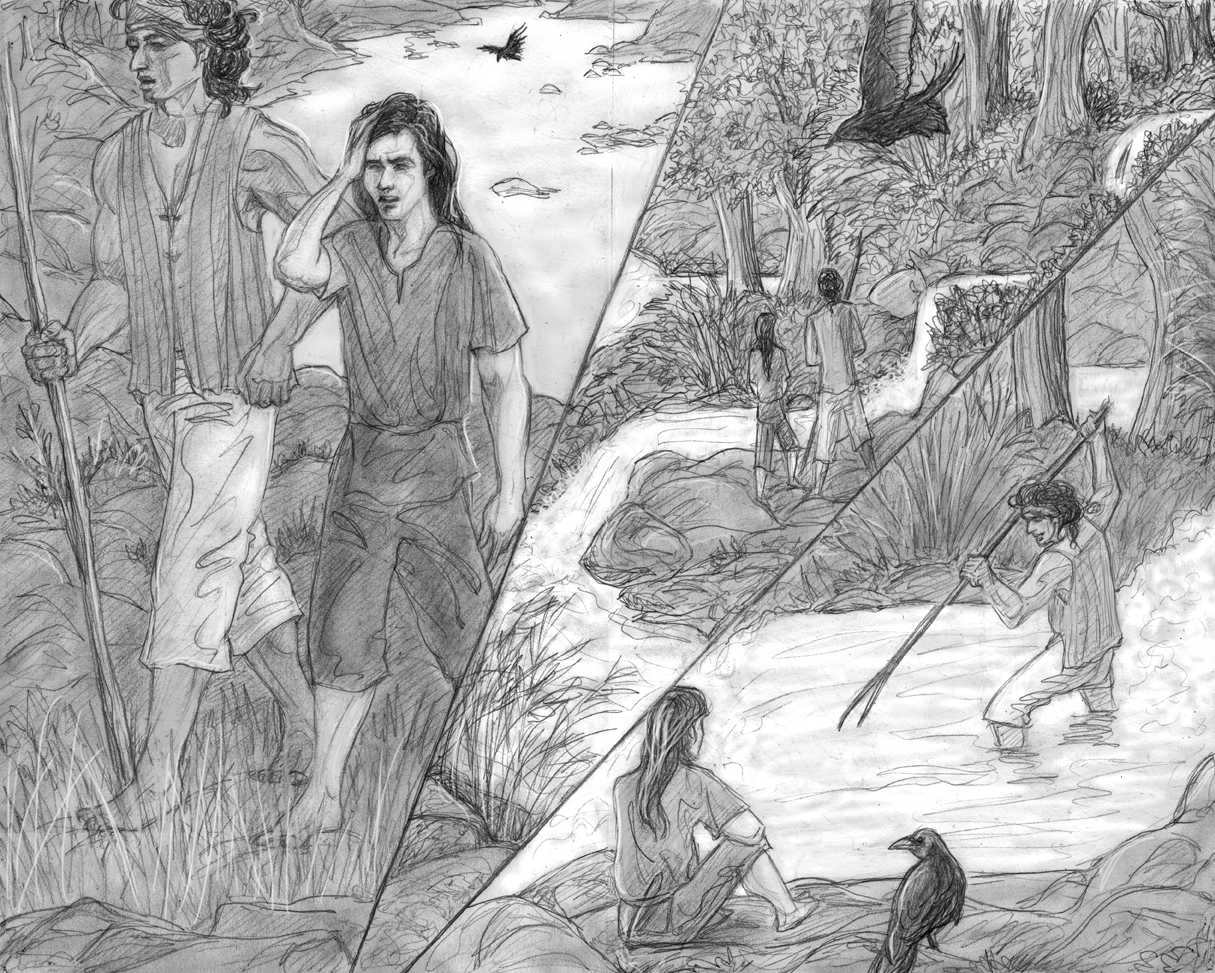THE HUMAN PARADIGM
What is a paradigm? It is simply a model, or the example. The human paradigm is the human that we all are not! Well, most of us. People vary about ten percent from the paradigm. Think of the paradigm as an average. In studies, people pick the average person for beauty, which makes sense. But that is prettiness, for real beauty, which is striking and exceptional, is a bit off the paradigm. The Greeks were the first to come up with "perfect" measurements for anatomy. A man was 7.5 heads tall, and women were about half a head shorter than men, but also 7.5 heads tall. Most people are seven heads tall, models about eight heads tall. Most of the variation is leg length. However, people vary quite a bit.


Quite a bit of traditional art schooling is anatomy, or the superficial anatomy of the human.
In most people, the fat layer covers much of the muscular form. Babies are the worst,
appearing like little sausages. Women tend to have more superficial fat than men do,
one of the indicators that we were once aquatic apes. Compared to other animals, we are
all legs and head, with no muzzle, no upper body, and in this strange upright position, with
no fur. Our skin tones vary according to where our ancestors lived on the planet, but the
most variation is in our faces. For the body, other than some skin differences, there is
not much racial variation, most of it being individual.
I kept asking in class why we studied male anatomy when all of our models were female. Males
seem to be the paradigm, which is just silly. The human paradigm, in my opinion, is a twelve
year old child. The differences in men and women go from there, branching out a bit in
each direction, some less than others. Males tend to have more upper body, females more
hips and breasts. The male face is a bit different, usually bonier across the eyebrow
ridge. But any male arm usually has the potential to be larger than the female. Most
females have larger legs than the male.

My standard for the human paradigm is the twelve year old child (apologies to the girls) who
happens to be 7-1/2 heads tall, and fit the measures exactly without any distraction of the
mature adult form. As you can see from these boys in action, the legs are large, the
head is large, and the amrs small by comparison. Given archeological evidence, the oldest
people had medium dark skin and straight hair, prominent noses, and probably looked very
much like this Lakota boy second from the left. Southern India, Australia and some of the
Americas have the oldest peoples, but Polynesian peoples are the mix. Caucasians are an
extreme, Mongolians another, and Africans another. The epicanthic fold came a bit later
to protect the sinuses from cold, and the other adaption was to encourage hair growth which
had not died out in adult men to the degree that it did in women and children. Whorled or
curly hair was also a late arrival as was the light and dark extremes of color that were
adaptions to sunlight variations. Boys and girls look pretty much the same at this age,
and you will see varying degrees of fat and muscle development.

Humans vary the most in their faces, their hair, and a bit on their overall body shape. Most of the world has divided humans into three body shapes, which tend to be invisible at twelve years old. There is a thin, bony type with small muscle body and often a long head. There is a middle type, muscular and "ideal." And there is a rounder type with more body fat on the surface which was probably a legacy type from when we were aquatic apes and body fat was essential to survival, especially the layer of fat everyone now despises. Let's look at body size.

This is a group of athletes. They are all of similar age, all fit, all top in their physical class and all superficially very different looking. But if we take the head as the standard measure, most of these men are four heads to the waist. The difference in height is not just in the overall size, but in the length of the legs. This is most obvious comparing the tall men in the middle with the tall men on the ends of the group. The tallest man on the left is over all of large size, but his legs are not. the man in the middle left has unusually long legs. The man second to the far right has a smaller head which will just give him the appearance of being larger when no compared to taller men.
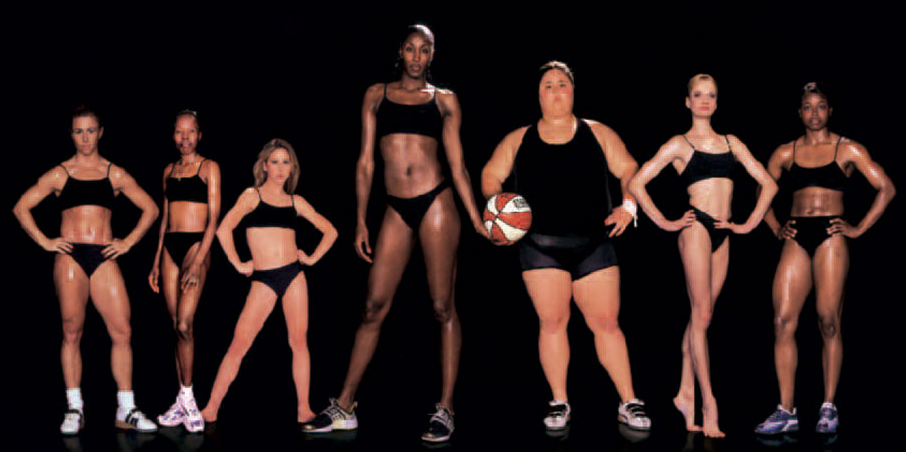
These women athletes vary also in height and leg length, but also in shape. Mesomorph, ectomorph, mesomorph, ectomorph, endomorph, ectomorph, and mesomorph. Our society favors tall ectomorphs for modelling clothing because they are like hangars. But most prefer the middle look, the mesomorph female who is not so muscular and not so tall. Our society is more strict with men, favoring only tall mesomorphs of a certain color range. Many books put these types as the paradigm, or the ideal as conceived by the Greeks.
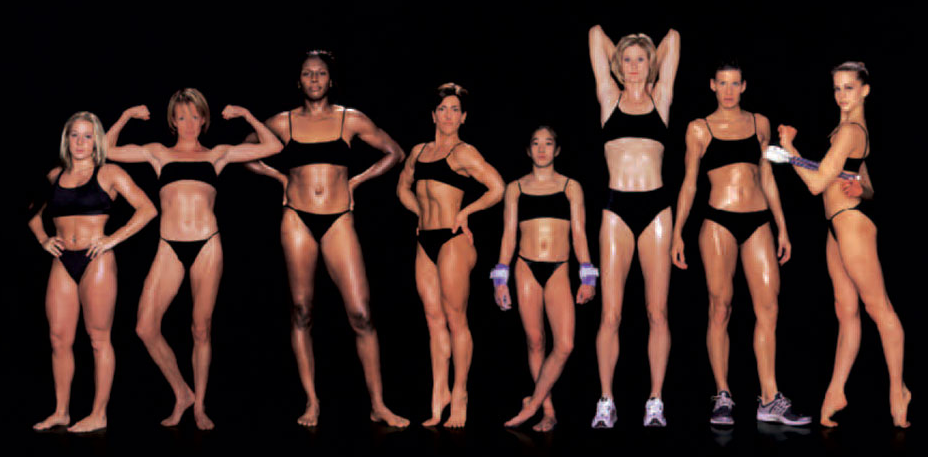
In this second row of women athletes, we see another range of types fitting more the American standards of female beauty. The range of heights here is more evident than the body types. Even the skin color is mid-tone, which is the preferred in the States where outdoor athletes are the paradigm and the only variation off of this is with fashion models who have a narrow appeal to clothes shoppers.
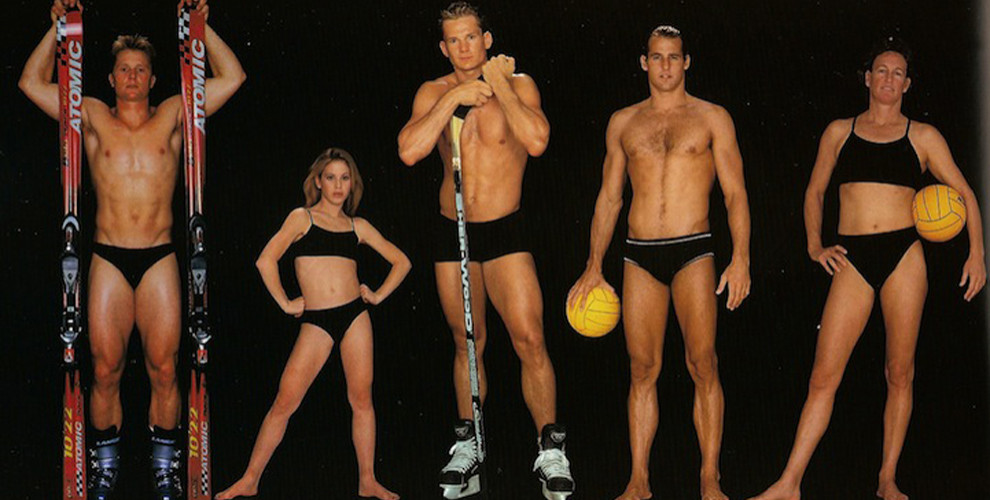
To further yank on the paradigm, the men fit it, and the woman on the left does also, but not the woman on the right, who is beautiful, fit, and athletic, but too large for the ideal. This small woman looks strange with the Nordic men! These people are not the extremes of human shapes, but paradigms shift with fashion.

Here we have more athletes and you can see the three extreme body types with two paradigms, one short and one tall, but both meeting the standard 7-1/2 heads, mesomorph, without hight musculature. All three of the women on the left fall out of the paradigm and out of the preferences of American standards.

In this photo of these athletes, I have left in the heights and put in the head measurements. Suddenly, you can see that there is some variation from the paradigm, even without the mask of preferred height and shape. The atlete on the far right is the only women who fits the Greek (Classical) paradigm of 7-1/2 heads! Shorter women often are not smaller, only shorter, and the reverse is true of tall women. The two tall women are eight heads tall, the two shorter women seven heads tall. I am also eight heads tall and I got in trouble in art classes for drawing everyone eight heads tall. However, this is my paradigm, since we were to measure ourselves for the standard. But let's look deeper. The women all seem to be close to three heads from head to waist and vary more in the leg length from four heads to five and a half heads. Be wary of books that tell you that heroes should be nine heads tall. They are not; they have longer legs.

Both these women fit the paradigm, but one is tall and one is not. There is actually hardly any difference between them, except height. The taller woman has longer legs. She is actually shorter waisted than the shorter woman.

Here is an amusing picture of three Hollywood actors, the man on the left being the famous baskeball star, Wilt Chamberlain. The man on the right is Andre the Giant. And Arnold, who seems so tall in the movies looks short. Much of the paradigm is comparison!

Here is a photo of and extreme ectomorph model and a mesomorph athlete. Normally, the male fills out in the chest, so the man on the left seems young. His lack of shoulder development makes his neck appear long. His chest is just as wide, but his lats are not developed so he seems thinner. Both men are health, but fit differently into the paradigm fo muscle development, not size.

You can see the difference in men and women from the back without the distracting sexual features. Women tend to look more bony from the back, especially across the shoulders since they gain weight in the waist and hips. Men tend to be more muscular across the upper body, even if they are thin or fat. In Classical drawing, the man is the paradigm, so this distracted anthropologists from the true paradigm leading them to think that people developed because of spear throwing. I know, it sounds funny to say it that way, but the human paradigm, when compared to other apes, is the huge legs, not the upper body.

Comare the human to the gorilla and you see what I mean. Humans are obviously streamlined. Although we think that men have ape bodies, there is no evidence to support it. The legs, even on the most developed man, are a so much longer and the arms so much shorter that no gorilla would have trouble in any wrestling contest! Humans look like frogs, not like apes.

Here we go, both pumped, the woman at the top of her muscular development, the man not extreme, but fit and a mesomorph. She just doesn't have the same arms. Women look more like the twelve year old paradigm except for some sexual variation. They have wider hips, breasts, and some superficial fat in the mid area. Men, on the other hand, have wider upper bodies, stronger jaws, that superorbital ridge, and all the upper arm development that makes everyone think "ape." For the Classicists to say that man is the paradigm and women and children the variations is a bit weird. If you want to study the human before you get distracted with sexual dimorphism, you have to watch boys running around. My closest approximation to the paradigm are not athletes, but dancers. They seem to keep the child's body shape without the distraction of the sexual development. Add on sex last, is my instruction.

For muscle development, not much beats dancers except for martial arts masters. Bruce Lee still has the best arm and upper body development of any photo model you can use for the male. Look at his here, with different muscles relaxed and stressed. He worked daily to develop strange muscle groups for the camera. Hulks like Arnold above are popular with Americans, but overdone. Drawing a range of muscular types is better than all hulks. Women tend to be drawn in more range, but in the States, the sexual aspects dominate all illustration that is adult.
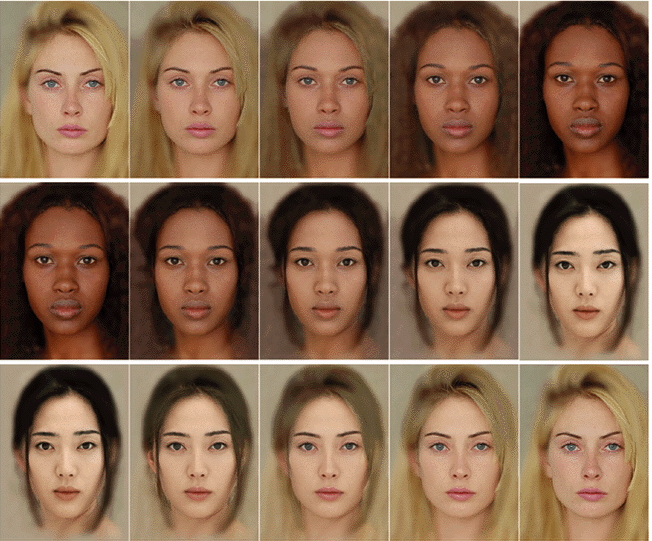
I'm going to leave you with the interesting computer morphing of faces that is fascination for many. Here we have three racial stereotypes (the Australian is missing) and their average. Fascinating picture. Most races set up a paradigm extreme which does not work well in "melting pot" cultures. After having done about 10,000 drawings, I prefer variety! If I have to draw the same face for a two hundred page graphic novel, I want a face that it more interesting. Average is pretty, interesting is beautiful.
